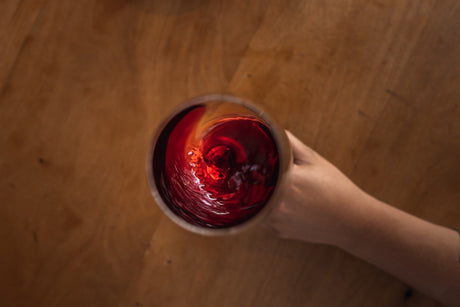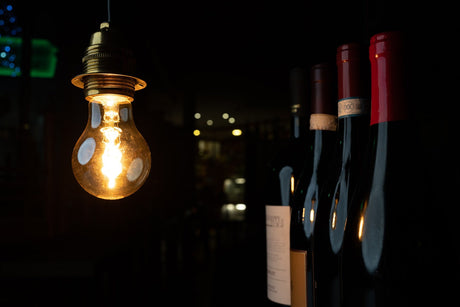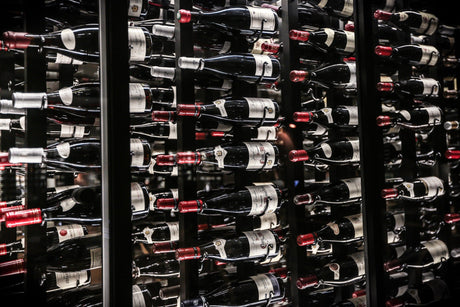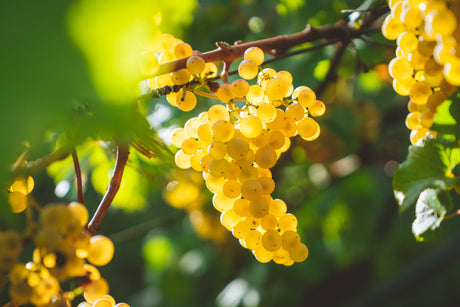
Mastering The Art of Decanting Wine: A Beginner's Guide
Don't be intimidated by decanting wine - it's not just for snobs! Learn why and how to do it with this fun, beginner-friendly guide from Your Wines. Cheers to better-tasting...
Winged Cat
Winged Cat Cabernet Sauvignon 2021 (12 bottles)
Brackenvine
Brackenvine Cabernet Sauvignon NV (12 Bottles)
Yellow Tail
Yellow Tail Shiraz Cabernet 2020 (12 bottles)
Bleeding Heart
Bleeding Heart Cabernet Sauvignon 2021 (12 bottles)
De Bortoli Wines
Deen Vat 9 Cabernet Sauvignon 2019 (12 Bottles)
Hardy's
Hardys VR 1Ltr Cabernet Sauvignon 2023 (12 bottles)
Mixed Cases
Uncork the Enigma: Our Secret Cabernet Sauvignon (12 Bottles)
Beaulieu Vineyard
Beaulieu Vineyard Rutherford Napa Valley Cabernet Sauvignon 2015 (Single Bottle)
Two Hands
Two Hands Sexy Beast Cabernet Sauvignon 2023 (12 bottles)
Grant Burge
Grant Burge GB88 Cabernet Sauvignon 2023 (12 bottles)
Grant Burge
Grant Burge Cameron Vale Cabernet Sauvignon 2022 (12 bottles)
De Bortoli Wines
De Bortoli Windy Peak Cabernet Sauvignon 2022 (12 Bottles)
Mount Lawson
Mount Lawson Cabernet Sauvignon 2021 (12 bottles)
Hesketh
Hesketh Coonawarra Cabernet Regional Selection 2021 (6 bottles)
Peter Lehmann
Peter Lehmann True Legend Cabernet Sauvignon 2019 (6 bottles)
McPherson Family Vineyards
McPherson Family Jock’s Cabernet Sauvignon 2022 (12 Bottles)
Barefoot Wine
Barefoot Cabernet Sauvignon, South East Australia 2023 (12 bottles)
The Hero Australia
The Hero Australia Cabernet Sauvignon Preservative Free Vegan 2022 (12 bottles)
The 50th Parallel Estate
Block 50 Cabernet Sauvignon, Central Ranges 2019 (12 bottles)
Bleasdale
Bleasdale Mulberry Tree Cabernet Sauvignon 2022 (12 Bottles)
Levantine Hill
Levant by Levantine Hill Cabernet Sauvignon, Yarra Valley 2021 (6 Bottles)
Kingston Estate
Kingston Estate Cabernet Sauvignon 2022 (12 Bottles)
Whether you're a seasoned connoisseur or a curious explorer of Cabernet Sauvignon, our collection caters to all palates. At Your Wines, we take pride in presenting an array of meticulously curated wines from top Australian and International producers, each bottle telling a story of craftsmanship and tradition.
Cabernet Sauvignon is a dry red wine with high tannins and heavy texture. It is not a sweet wine; if you are looking for something sweet, you should go for Port or Sherry.
Some of the best regions in Australia to find Cabernet Sauvignon wines are Coonawarra, Margaret River, McLaren Vale, and Yarra Valley. These regions have a unique climate and soil that provides optimal conditions for the growth of Cabernet Sauvignon grapes.
Cabernet Sauvignon is a full-bodied red wine that tastes best at room temperature between 15-18 degrees Celsius. However, you can serve it between 10-15 degrees Celsius if you prefer to consume it chilled. It is not recommended to serve Cabernet Sauvignon too cold as it can cause the flavours to flatten.
Cabernet Sauvignon is a bold wine with heavy tannins and rich texture. It has a deep, dark colour and tastes like black currant, blackberry, cedar, and sometimes vanilla. Its distinct aroma is described as "cassis" or "black currant bud."
The best time to drink Cabernet Sauvignon depends on the wine's age and maturity. If you have a young Cabernet Sauvignon, drinking it within 5 years of its vintage date is recommended. However, an aged Cabernet Sauvignon can be enjoyed up to 15 years or even more after its vintage date.
It is subjective to declare one Cabernet Sauvignon as the best in Australia, as everyone's palate differs. However, some of the most popular Cabernet Sauvignon wines in Australia are Coonawarra Cabernet Sauvignon, Penfolds Cabernet Sauvignon, Margaret River Cabernet Sauvignon, and Yarra Valley Cabernet Sauvignon.
Cabernet Sauvignon is a popular wine worldwide due to its versatility, full-bodied flavour, and high tannins. It pairs well with many foods, such as red meat, lamb, and gourmet cheeses. Additionally, Cabernet Sauvignon can age for many years, making it a favourite of wine collectors worldwide.
Cabernet Sauvignon and Cabernet Franc are often confused, but they are two different grape varieties. Cabernet Sauvignon is a full-bodied red wine known for its high tannins, bold flavours, and rich texture. On the other hand, Cabernet Franc is a lighter-bodied red wine that is less tannic and has a subtle aroma of strawberries and raspberries.
Cabernet Sauvignon pairs exceptionally well with rich, hearty dishes. Its bold flavours complement red meats like steak and lamb and aged cheeses. The wine's tannins also work harmoniously with the fats in these foods. Additionally, dark chocolate and dishes featuring herbs like rosemary and thyme can enhance the overall tasting experience. For a more detailed exploration of perfect pairings, check out our blog.
Now that you know everything there is to know about Cabernet Sauvignon, why not try some for yourself? You can easily buy Cabernet online here at Your Wines and discover why it's one of Australia's most loved red wines. Cheers!

Don't be intimidated by decanting wine - it's not just for snobs! Learn why and how to do it with this fun, beginner-friendly guide from Your Wines. Cheers to better-tasting...

Bored with the same old Pinot Noir? These five alternative red wines share some characteristics of your favourite Pinot but also bring something new to spice things up. Cheers to...

Want to impress your friends with some fancy wine tricks? Look no further! From quick chilling methods to uncorking without a corkscrew, these clever tips will elevate your wine game....

Spice up your New Year's Eve celebrations with our list of the best sparkling wines Australia has to offer. From crisp and refreshing to full-bodied and complex, find your perfect...

Who says sparkling wine is just for special occasions? Discover 5 fun and unexpected pairings that elevate your everyday Aussie snacking experience. Cheers!

Join us on an adventure to uncover the history and allure behind Australia's love for Shiraz. From its bold flavours to its global recognition, discover why this wine reigns supreme...

Are you a Chardonnay lover looking to expand your wine horizons? Check out these top five alternative white wines that are sure to impress your palate and liven up any...

Who says celebrations have to be expensive? Check out these five pocket-friendly sparkling wine suggestions that will make your taste buds dance. Perfect for holidays, special occasions, or just a...

Get ready to sip your way into summer with these amazing wine pairings for seafood dishes! Find out which wines will perfectly accompany all your favourite dishes.